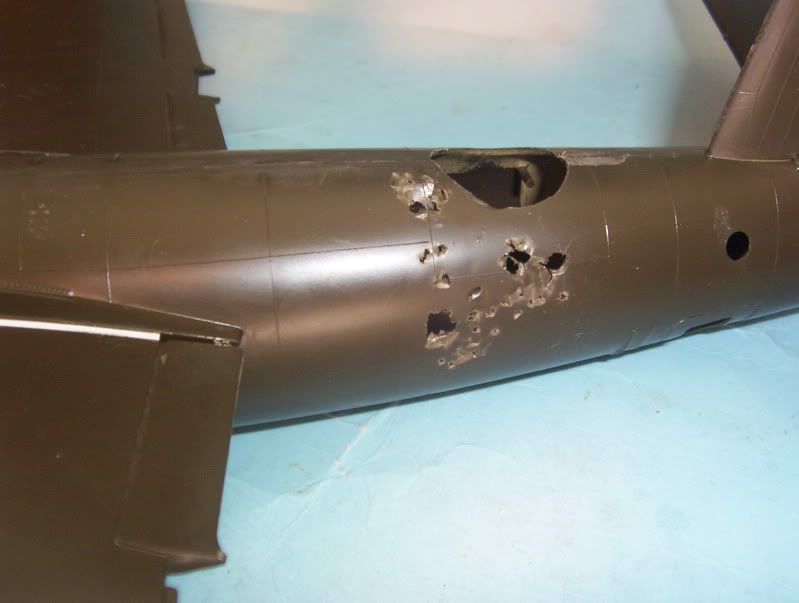Bullet and shrapnel-holes are best done by thinning the plastic out from behind, grinding it away until it's paper-thin (I use a steel-cutter bit in a motor-tool)... Then using your knife-point, punch through it from the outside for entry-holes, and inside for exit-holes, and give it a little twist... By thinning the plastic, you not only make it easy to punch through, but you scale down the thickness too, which makes the "skin" look the right thickness...
You can also use a heated knife-point or a sewing-needle to make the round holes.. Don't forget to slice off the little ridge that will appaer around the melted edges though..
Shep Paine describes the technique here:
http://sheperdpaine.atspace.com/b17g.htm

The above shot is my depiction of a rather muderous hit by a burst of of 20mm and 7.92mm from a Bf109 to a B-26's waist... Key things to remember about that stuff is that shrapnel is jagged, and can be from the size of a splinter or a fist, and rifle-caliber ball ammo will be round holes, provided the bullets struck at more or less a right-angle.. Oblique bullet-hits will tend to be "gouges" or "tears" instead... HE cannon-rounds tended to pierce the skin and explode inside..
Heavy machine guns, like the 13mm and .50 cal tend to be AP or API (Armor-Piercing and Armor Piercing-Incediary), Ball, and Tracer, and they tear larges chunks of airplane away when they hit... Neither weapon is a "sewing machine" and long rows of evenly-spaced holes just don't happen... Once you've painted and decaled the model, don't forget to show a little "flaked" paint around the perimeter of the hole.. I use plain ol' silver for that..
For smoke and flame, well.. There's just no good way to to model flames in any scale.. Flames cause light to shine and shadows to be cast, and you can't do that with paint.. You can suggest it, but it still never looks quite right outside a shadow-box diorama.. I've used spun-glass "angel-hair" from a Christmas ornament I found and a grain-of-rice bulb light-source with some success though never "outside the box".. Forget about "dancing flames" though.. "Animating" it looks wrong, no matter what...
Smoke is another thing that's hard to model, although cotton works about the best as far as materials go.. Then it's a matter of spray-painting it with several colors, ranging from black through several shades of browns, to a dirty brownish-grey... You'll also have to form the cotton from solid-looking at the sorce to billowy and "see-through" at the end...
If it's a matter of display-area though, might I suggest that you put them in "formations" hanging from the ceiling rather than in a fight? Three single-seat, single-engine 1/32 fighters (in an RAF-type "Vic" or "Vee") would fit quite nicely into a 3' x 5' area (or for "Finger Four" or "Schwarm" formation, 4' x 6')...
Also, there's a few members here who also hang their planes from the walls by placing hooks on the wall and using a wire at the tail to hang them, "picture-style" in a vertical display...